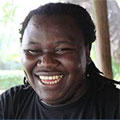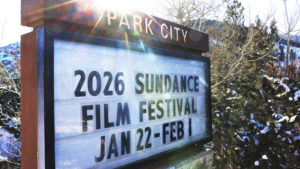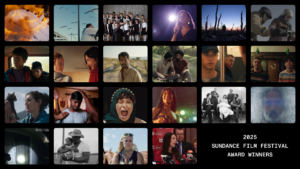Director Indhu Rubasingham (second from left) and Mrisho Mpoto (third from left) rehearse Africa Kills Her Sun. Photo by Fred Hayes
John Price
John Price is the former U.S. Ambassador to Mauritius, Seychelles, and Comoros and a founding board member of the Utah Committee for Sundance Institute. Below he recounts his experience at last month’s Sundance Institute Theatre Lab, where he attended a rehearsal of the lab project “Africa Kills Her Sun.” This blog was originally published on Price’s personal website.
On Wednesday evening July 25, Marcia and I attended the 2012 Sundance Institute Theatre Lab production of the play Africa Kills Her Sun, or Afrika Inaua Mwangaza Wake in Kiswahili. The play had a cast of three African actors and one American actor, who passionately expressed the plight of the Ogoni people in Nigeria under the dictator Sani Abacha, whose ruthless regime was noted for widespread corruption, human rights abuses, and the suppression of free speech.
The Rehearsal Hall at the Sundance Resort was filled with more than 100 enthusiastic Lab attendees from the United States, Africa, and other parts of the world. To everyone’s pleasant surprise, Robert Redford and his wife Sibylle were in the audience. The play brought back memories of our many visits to sub-Saharan Africa over the past 40 years, starting with our first trip to East Africa in 1970, visiting Kenya, Uganda, Ethiopia, and Tanzania.
I applaud Sundance Institute for supporting this production, which brings into focus some of the injustices in Africa through social awareness, and reaching out to inquisitive young minds. We were pleased that the Theatre Lab play was a collaboration with African playwrights and actors.
Ken Saro-Wiwa had written the short story from which the play was adapted. He was a vocal critic of Shell Oil Company and the brutal government of General Sani Abacha who controlled Nigeria. He advocated on behalf of the Ogoni people who lived in abject poverty in the oil-rich Niger Delta region.
A popular writer, satirist, and television producer, Saro-Wiwa was a political activist who led a movement that swelled to over 300,000 protestors, which Abasha felt was a threat to his administration. Ken Saro-Wiwa was jailed in 1994, and put on trial with eight other leaders of the uprising. In a biased trial they were found guilty and quickly executed in 1995. There was a worldwide outcry, but little changed for the poverty stricken and destitute Nigerians. Wiwa became a folk hero for other Africans’ suffering from human rights abuses and injustices.
The original story by Ken Saro-Wiwa was based on the condemned man’s last letter to his beloved. Mrisho Mpoto, Irene Sanga, and Elidady Msangi adapted the story into Kiswahili, combining slam poetry and storytelling, to talk about the corruption and inhumane treatment that had taken place in Nigeria. People still face similar injustices today in sub-Saharan Africa, where dictators and autocratic rulers control over 15 countries, and 20 countries are considered failing or failed states.
In many of these countries, freedom of speech and political activism are suppressed, as well as satirical theatre performances. According to George Ayittey, a well-known Ghanaian economist, “Africa has more dictators per capita than any other continent. In 1990, only 4 out of the 54 African countries were democratic; today, 21 years later, it is only 15”.
Sundance Institute was founded in 1981 by Robert Redford, the well-known actor-artist, director, and producer. He had a vision of discovering and developing independent artists to encourage “artistic expression and social and political awareness.” The Institute “seeks to discover, support, and inspire independent film and theatre artists from the United States and around the world, and to introduce audiences to their new work.”
I first met Robert Redford in 1981 after he established Sundance Institute at the Provo Canyon Resort. At the time, I owned a television station and produced soap operas. I was asked to be a member of the Advisory Board of the Friends of Sundance Institute. In 1986, Redford asked me to serve as one of the founding board members of the Utah Committee for the Sundance Institute.
Sundance had grown, and began developing emerging filmmakers, directors, composers, screenwriters, playwrights, and performing artists, who interfaced with successful industry mentors. The outgrowth of these efforts was the renowned Sundance Film Festival in Park City, Utah.
In 1996, Philip Himberg, the artistic director for the Sundance Institute Theatre Lab program, opened the doors to aspiring international artists. The following year artists came from Kenya and Uganda, where reportedly they had long suffered discrimination and political isolation.
Subsequently, artists from Tanzania, Rwanda, Burundi, and Ethiopia were included in the program. It was noted that a new generation of artists were emerging, offering “the potential for authentic cultural revitalization – a first step toward social, political, and economic equilibrium- a powerful artistic platform for positive social change.” The participants had an opportunity to meet with American theatre experts, and share their experiences.
The Sundance Institute East Africa Theatre Program became a successful endeavor, starting in 2008 when several American artists met with artists from Rwanda and Tanzania, and subsequently from Ethiopia and Uganda. In 2010, Sundance Institute held its first East Africa Theatre Lab on the island of Manda in Kenya. It was a three-week retreat that provided the artists with the support of directors, dramaturges, and mentors. Eight projects developed by artists from Kenya, Tanzania, Ethiopia, Uganda and Rwanda were selected.
At the 2012 Sundance Institute Theatre Lab, Philip Himberg and Producing Director Christopher Hibma—along with their team—selected eight plays, with actors from Tanzania, Uganda, Nigeria, New York, Chicago, and Hawaii. The play Africa Kills Her Sun, directed by Indhu Rubasingham, was one of those selected.
The Sundance Institute Theatre Program intends to develop actors, writers, directors, musicians, composers, and producers, and give them the opportunity to network with American theatre experts and legends and share their rich African cultures. Americans need to know more about this far away continent and its multi-cultural tribal history going back hundreds of years.
Third world countries today are no longer isolated, and increasingly are becoming intertwined with life in the United States. Africans, however, continue to struggle with injustices, a legacy from the colonial era. Power and wealth are still held in a few hands; poverty, corruption, violence, and disease continue to run rampant in much of Africa. Writers and performing artists through their inspired works “are able to bridge social, economic, religious, and cultural divides using the common language of art, to explore and express these common humanity issues.”
Sundance Institute is helping expose Americans to the different cultures of African society; the inequities they have suffered at the hands of dictators and autocratic rulers; corruption and inhumane abuses; the positive effects of conflict resolution, the scourge of the continent, as seen through the eyes of actors-artists, writers, and producers. I applaud Robert Redford’s vision, embraced by the Sundance Institute Theatre Program, “what Africa can become with artistic endeavor.”




